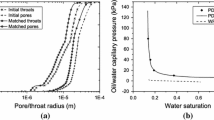Abstract
The pressure of the pore water in a porous material is a measure of the state of the water.
Access provided by CONRICYT-eBooks. Download chapter PDF
Similar content being viewed by others
The pressure of the pore water in a porous material is a measure of the state of the water. The pore water pressure Pw is related to the RH in the pores with the Kelvin equation
where psat is the vapour pressure at saturation, R is the gas constant, T is the absolute temperature, ρ is the density of water, Mw is the molar weight of water and φ is the relative humidity. For RH <100% the pore water is negative.
The pore water pressure is related to the capillary rise h (m) or capillary suction with the gravity g and density ρ
The pore water pressure is related to the moisture content via a “suction curve” where the moisture content is given as functions of the pore water pressure or the capillary rise, similar to a sorption isotherm where RH is the independent variable. An example is given in Fig. 11.1. Note the scale on the horizontal axis with a capillary rise from 1 cm to 10 km.
For RH close to 100% RH the RH is difficult to measure with good accuracy. One possibility is then to measure the pore water pressure directly, with a pressure transducer.
An ISO standard (ISO 11276:1995) describes methods for the determination of pore water pressure in unsaturated and saturated soil using a tensiometer. The methods are applicable for in situ measurements in the field and soil cores.
For saturated soils traditional manometers of various types are used to measure the (positive) water pressure. Both for unsaturated soils and unsaturated building materials the pore water pressures are negative, however. That makes the pressure measurement somewhat more complicated. Traditional pressure transducers can still be used but the water next to the transducer must be de-aerated, Radocea (1992), which can be achieved by boiling the water.
Radocea (1992) used a simple pressure transducer connected to a small needle, cf. Figs. 11.2 and 11.3, to measure pore water pressures in fresh concrete.
An example of Radocea’s results is shown in Fig. 11.4.
Pore water pressures down to close to −1 bar could be determined. In many cases, however, the water inside the needle collapsed at higher pressures than that due to entrapped air voids expanding.
Fagerlund (1973) presented a modified suction plate apparatus for determining the pore water pressure of a sample, cf. Fig. 11.5.
The sample is placed on the porous plate and covered with a protection against evaporation. The sample will suck water from the flow-tube. Decreasing the pressure with a vacuum pump prevents this. The pressure is adjusted so the meniscus in the flow-tube is kept fixed in position. The pore water pressure is read from a manometer or pressure transducer. Fagerlund (1973) claimed the technique is applicable for pressures down to −105 Pa.
The limitations are of course the possibilities to achieve good contact between the sample and the porous plate.
Author information
Authors and Affiliations
Corresponding author
Editor information
Editors and Affiliations
Rights and permissions
Copyright information
© 2018 RILEM
About this chapter
Cite this chapter
Nilsson, LO. (2018). Pore Water Pressure. In: Nilsson, LO. (eds) Methods of Measuring Moisture in Building Materials and Structures. RILEM State-of-the-Art Reports, vol 26. Springer, Cham. https://doi.org/10.1007/978-3-319-74231-1_11
Download citation
DOI: https://doi.org/10.1007/978-3-319-74231-1_11
Published:
Publisher Name: Springer, Cham
Print ISBN: 978-3-319-74230-4
Online ISBN: 978-3-319-74231-1
eBook Packages: EngineeringEngineering (R0)









